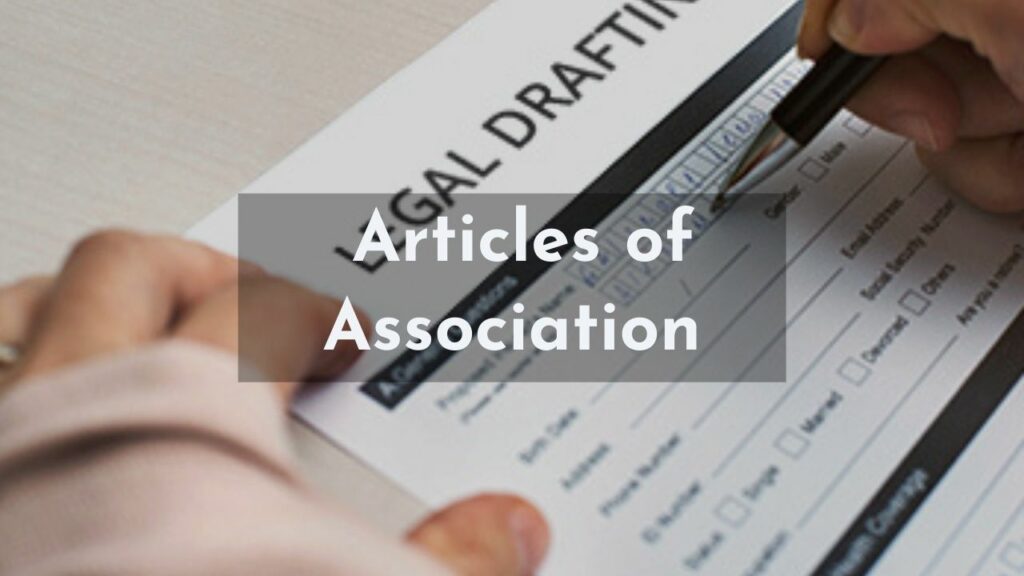A legal document known as the Articles of Association (AoA) lays out the goals of a company and the regulations that will govern its operations. The article outlines the proper way to carry out duties inside an organisation, such as the creation and management of financial records and the selection of directors.

Components of the Articles of Association
Typically, a business’s articles of association will specify how it issues shares, pays dividends, and keeps financial records. The purpose of the paper is to educate the reader on the strategies used by businesses to meet their daily, monthly, and yearly objectives.
Even if the particular vocabulary and purposes change, the articles of association are broadly similar in many nations. In general, it includes the following:
- Provisions on the company name.
- Purpose of the company.
- Share Capital.
- Organization of the company.
- Provisions on shareholder meetings.
Provisions on the company name
As a legal entity, a corporation must have an official name. It must be incorporated in the articles of incorporation of the organisation. Typically, the suffixes “Inc” or “Ltd” are used to denote that an entity is a company. Please bear in mind that regulations vary by country, and as a result, there are many limits limiting business name
Purpose of the company
Businesses are created for a specific reason. It is primarily a profit incentive to attain a goal through providing value to society. The articles of incorporation must describe the organization’s raison d’être or mission precisely.
While some countries permit relatively broad goal declarations, such as “management,” others demand a more specific purpose statement, such as “the operation and expansion of a restaurant chain.”
Share Capital
The articles of association will specify the amount and kind of shares that make up the capital of a business. Typically, a corporation’s capital is made up of at least one type of common stock. Additionally, other forms of preferred stock are available.
If the articles of association contain information concerning stocks, it signifies that the firm may issue them in the event of a financial requirement.
Organization of the company
The document contains legal information about the business, such as the registered address, the number of directors and workers, and the founders’ and initial shareholders’ identities.
Legal advisors and auditors may also be listed here, depending on the nature of the firm and the jurisdiction of the nation.
Provisions on shareholder meetings
The regulations regulating the first general shareholder meeting are detailed in the section on shareholder meetings. Furthermore, the section discusses the notifications, motions, and votes that will govern future annual shareholder meetings.
Contents of Articles of Association
Contents of the Articles of Association of a limited company are prescribed in Table F of the Companies Act, 2013. Generally, the contents of AOA are as follows:
- Interpretation
- Private Company
- Share Capital and Variation Of Rights
- Preference Shares
- Alteration to Memorandum
- Control of Shares
- Shares held Jointly
- Increase of Capital
- Lien on Shares
- Calls on Shares And Transfer Of Shares
- Transmission of Shares
- Forfeiture of Shares
- Alteration of Capital
- Capitalisation of Profits
- Buy-Back of Shares
- Issue of Shares In-Kind
- General Meetings
- Proceedings at General Meetings
- Voting Rights and Proxy
- Directors
- Proceedings of The Board
- Chief Executive Officer, Manager, Company Secretary or Chief Financial Officer.
- Common Seal
- Borrowing Powers
- Operation of Bank Accounts
- Dividends and Reserve
- Accounts
- Audit
- Winding Up
- Secrecy
- Indemnity
- Execution Clause
| Particulars | MOA | AOA |
| Description | Defines the company’s constitution, powers, objectives, and constraints of the organisation. | Defines rules and regulations of the company. It also defines the duties, powers, liabilities and rights of individuals associated with the organisation. |
| Contents | It contains the five mandatory clauses. | It contains the provisions as per the requirements of the organisation. |
| Filing at the time of registration | It is a mandatory document that must be filed with the ROC at the time of company registration. | The drafting of AOA is mandatory. However, the filing of AOA with the ROC is optional at the time of company registration. |
| Importance and position | MOA is a supreme legal document and subordinate to the Companies Act. | AOA is subordinate to the MoA and the Companies Act. |
| The relationship between the two | MOA is a dominant document that helps in the drafting of the AoA. | Any provision in the AOA that contradicts the MoA is considered null and void. |
| Alteration | An alteration can be made in the MOA only after passing a special resolution in the Annual General Meeting (AGM) and after obtaining prior approval from the Central Government. | An alteration in the AOA can be made by passing a special resolution in the Annual General Meeting (AGM). |
| Retrospective amendment | The MOA cannot be amended with a retrospective effect. | The AOA can be amended retrospectively. |

